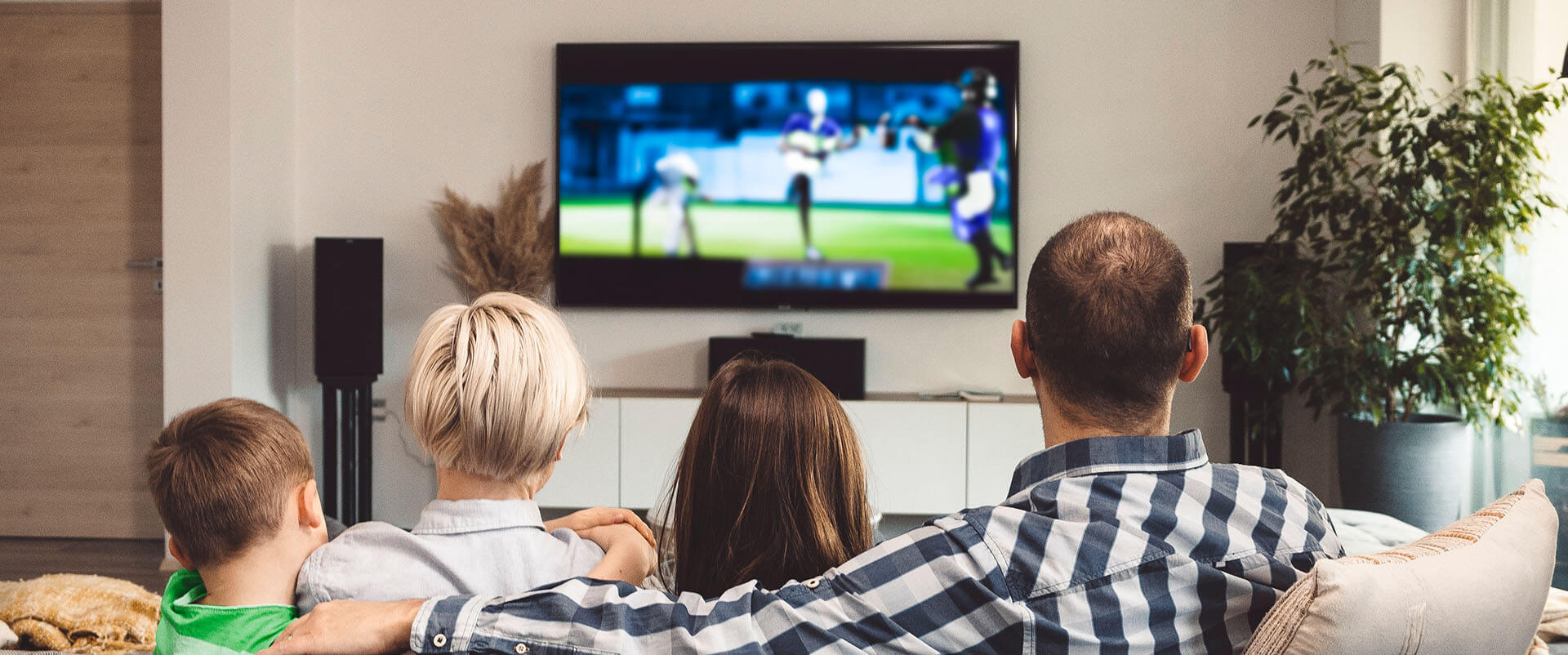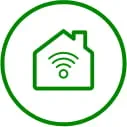The entertainment landscape has dramatically shifted over the past decade, with millions of households moving away from traditional cable TV to streaming services. As your local fiber internet provider, Ziply Fiber offers the ideal foundation for this modern entertainment approach with our lightning-fast, reliable connections.
Streaming offers numerous advantages over conventional cable:
- Flexibility: Watch your favorite shows and movies on your timeline, not according to a rigid broadcast schedule. Pause, rewind and watch content at 2 AM or 2 PM -- it's entirely up to you.
- Device versatility: Access your entertainment on smart TVs, phones, tablets, laptops, gaming consoles and more -- perfect for watching in any room or while traveling.
- Cost savings: Most households experience savings by switching from traditional cable packages to a combination of streaming services tailored to their viewing preferences.
- No equipment rental fees: Eliminate monthly DVR and cable box rental charges that typically add to the monthly bill.
- Contract freedom: Enjoy month-to-month subscriptions with the ability to cancel or switch services anytime without early termination penalties.
- Content personalization: Receive recommendations based on your viewing history rather than watching whatever happens to be broadcasting.
Best streaming services in 2025
On-demand streaming
Netflix
Hulu
Disney+
Amazon Prime Video
Live TV streaming
YouTube TV
Hulu + Live TV
Sling TV
Free streaming options
Pluto TV
- Extensive channel lineup
- Specialized theme channels
- On-demand library
- Platform integration
- Customization features
- Content Highlights
Tubi
- Massive content library
- Limited commercial interruptions
- Advanced categorization
- Personalization engine
- Kids Mode
- Weekly content updates
Freevee
- Premium original content
- Recently added movies
- Fast Channel feature
- X-Ray integration
- Cross-platform availability
Network apps with free content
Popular streaming devices
Roku options
Amazon Fire TV options
Apple TV
Chromecast
Understanding streaming basics
What is streaming?
Streaming refers to the continuous transmission of audio or video files from a server to a client. Instead of downloading entire media files before playing them, streaming sends data in a continuous flow, allowing you to watch or listen immediately.
How streaming differs from traditional cable
Unlike cable TV, which delivers pre-scheduled programming through a physical cable connection, streaming services provide:
- On-demand accessibility: Access entire seasons and libraries of content immediately rather than waiting for weekly episode releases or reruns.
- Cross-platform compatibility: Start watching on your TV and continue on your phone or tablet seamlessly without missing a moment.
- Personalized user profiles: Create individual profiles for each family member with custom recommendations and viewing history.
- Enhanced content discovery: Find new shows and movies through sophisticated recommendation algorithms based on your unique preferences.
- Flexible subscription management: Add or remove services seasonally based on content offerings.
- Interactive viewing experiences: Explore bonus features, alternate endings and behind-the-scenes content not available through traditional broadcasting.
- Ad customization options: Choose between ad-supported tiers at lower prices or ad-free experiences for uninterrupted viewing.
Essential equipment for streaming
Smart TVs vs. streaming devices
Built-in smart TV capabilities
Most modern TVs come with smart capabilities, featuring pre-installed apps. The advantages include:
- Simplified setup process: Begin streaming immediately after connecting to WiFi without additional hardware installation or HDMI port management.
- Reduced cable clutter: Eliminate extra devices, power adapters and HDMI cables from your entertainment center for a cleaner aesthetic.
- Single remote convenience: Control your entire viewing experience with one remote rather than juggling multiple control devices.
- Integrated content discovery: Access unified search functions that scan across multiple streaming services simultaneously.
- Automatic software updates: Receive manufacturer-pushed system updates that maintain compatibility with streaming services.
However, smart TVs may have limitations:
- Processor limitations: Less powerful CPUs and GPUs compared to dedicated streaming devices, resulting in slower menu navigation and app loading.
- Update longevity concerns: Manufacturers typically provide software updates for only 2-4 years, potentially leading to app incompatibility issues.
- App selection restrictions: Fewer available apps compared to dedicated streaming platforms, particularly for niche content services.
- User interface inconsistencies: Varying interface quality and responsiveness depending on TV brand and model year.
- Memory constraints: Limited RAM and storage can cause performance degradation when multiple apps are installed.
Internet setup for optimal streaming
Router placement tips
- Central, elevated location: Position your router on a shelf or desk (at least 5-6 feet high) in a central area of your home to maximize signal distribution; avoid closets, cabinets or enclosed spaces.
- Interference minimization: Keep router at least 3-5 feet away from microwaves, cordless phones, baby monitors, Bluetooth devices and large metal objects that can disrupt signal transmission.
- Antenna orientation: For routers with adjustable antennas, position some vertically and others horizontally to optimize both horizontal and vertical signal coverage throughout your home.
- Wall and floor consideration: Each wall reduces signal strength by 25-40%, while floors with electrical wiring or plumbing can reduce signals by 40-50%; position accordingly to minimize these obstacles.
- Heat ventilation: Ensure adequate airflow around your router to prevent overheating, which can significantly reduce performance and shorten device lifespan.
- Strategic placement for primary devices: When possible, position router in direct line-of-sight to your main streaming devices for strongest signal transmission.
See our Whole Home WiFi service
WiFi vs. Ethernet connections
- Wired ethernet advantages: Delivers consistent speeds, eliminates interference issues, provides superior stability and reduces security vulnerabilities.
- Wireless convenience trade-offs: Offers flexibility without cable management but typically delivers less speed than rated maximums due to environmental factors and device limitations.
- Strategic hybrid approach: Connect primary fixed entertainment devices (main TV, gaming consoles) via Ethernet while using WiFi for mobile devices and secondary streaming locations.
- Cable quality considerations: Use high quality Ethernet cables for future-proofing and superior performance; avoid bargain cables that may fail to meet specifications.
- Powerline adapters alternative: Consider powerline ethernet adapters that use home electrical wiring when direct ethernet wiring isn't feasible.
- MoCA adapters option: For homes with existing coaxial cable wiring, MoCA adapters can provide near-Ethernet quality connections.
Network optimization techniques
- Enable Quality of Service (QoS) settings: Prioritize streaming traffic over background downloads and updates to prevent buffering during peak usage times.
- Implement band steering: Configure your dual-band router to automatically direct devices to appropriate frequency bands based on capability and location for optimal performance.
- Schedule automatic router reboots: Set your router to restart weekly during low-usage hours (like 4 AM) to clear memory and refresh connections.
- Separate IoT devices: Create a guest network for smart home devices to prevent them from competing with streaming bandwidth and enhance security.
- Enable beamforming: Activate this feature on compatible routers to focus wireless signals toward connected devices rather than broadcasting omnidirectionally.
Troubleshooting common connection issues
- Systematic router reset procedure: Power cycle your modem and router by unplugging both for 60 seconds, reconnecting modem first, then router, allowing full 2-3 minutes for complete restart.
- Signal strength diagnostics: Use WiFi analyzer apps to identify channel congestion and signal strength throughout your home; reposition router or add extenders for readings below -70dBm.
- Interference identification: Temporarily disconnect potential interference sources one-by-one to isolate problems.
- Firmware verification: Check router manufacturer's website quarterly for firmware updates that address security vulnerabilities and performance issues.
- Speed test documentation: Learn how to test your internet speed and interpret the results by visiting our blog: How to test your internet speed. Run speed tests at different times of day and document your results to identify patterns and determine if issues are time-specific.
- Hardware elimination testing: Connect a device directly to your modem via ethernet to determine if router is causing performance issues; speeds should match your subscription rate.
Watch every Rip City moment with BlazerVision and Ziply Fiber
Blazer fans, this one's for you. BlazerVision is the Portland Trail Blazers' official streaming service for in-market fans, offering every locally broadcast game live and direct to you—no cable subscription necessary.
Unlike national sports packages or streaming bundles, BlazerVision is made just for fans in the Trail Blazers' broadcast region. That means you get the games that matter most, without blackouts or bouncing between networks. Just check your ZIP code on trailblazers.com/blazervision to confirm availability in your area.
How to watch:
Stream BlazerVision through the NBA app, NBA.com, or compatible smart TVs and streaming devices. Once you sign up, it's easy to tune in wherever and whenever you want—whether you're at home or on the go.
What it costs:
See the current pricing for a full season of BlazerVision is available here.
Why Ziply Fiber makes it even better
No buffering. No lag. No missing the buzzer-beater. Pair BlazerVision with Ziply Fiber's ultra-reliable, high-speed fiber internet for a viewing experience that's as fast and fearless as the Blazers themselves. With symmetrical speeds and no data caps, Ziply Fiber gives your stream the bandwidth it needs—so you can focus on the game, not the loading screen.
Stream into the future with Ziply Fiber
The future of TV is streaming, and with Ziply Fiber's reliable high-speed internet, you're perfectly positioned to embrace this evolution. As streaming technology continues to advance with better picture quality, more interactive features and smarter recommendations, your fiber connection ensures you'll be ready for whatever comes next.
If you need assistance optimizing your home network for streaming or have questions about upgrading your internet speed, Ziply Fiber's 24/7 customer support team is ready to help. Contact us at 1-866-ZIPLYFIBER or visit ziplyfiber.com/support.
Additional resources
- How to test your internet speed
- Ziply Fiber Customer Support
- Ziply Fiber Streaming Finder
- Internet Optimization Guide
Start enjoying the freedom, flexibility and endless entertainment options that streaming offers, powered by Ziply Fiber's lightning-fast internet.






